The chaos engineering platform market stands at the threshold of a decade-long expansion trajectory that promises to reshape software reliability technology and system resilience solutions. The market's journey from USD 843.1 million in 2025 to USD 1,260 million by 2035 represents substantial growth, demonstrating the accelerating adoption of advanced reliability testing and failure simulation optimization across financial institutions, e-commerce operations, and telecommunications sectors.
The first half of the decade (2025-2030) will witness the market climbing from USD 843.1 million to approximately USD 990.2 million, adding USD 147.1 million in value, which constitutes 35% of the total forecast growth period. This phase will be characterized by the rapid adoption of cloud-based chaos platforms, driven by increasing digital transformation initiatives and the growing need for advanced system reliability solutions worldwide. Enhanced failure simulation capabilities and automated resilience testing systems will become standard expectations rather than premium options.
The latter half (2030-2035) will witness continued growth from USD 990.2 million to USD 1,260 million, representing an addition of USD 269.9 million or 65% of the decade's expansion. This period will be defined by mass market penetration of comprehensive resilience platforms, integration with DevOps and observability ecosystems, and seamless compatibility with existing software development infrastructure. The market trajectory signals fundamental shifts in how technology organizations approach system reliability and incident prevention, with participants positioned to benefit from growing demand across multiple deployment models and application segments.
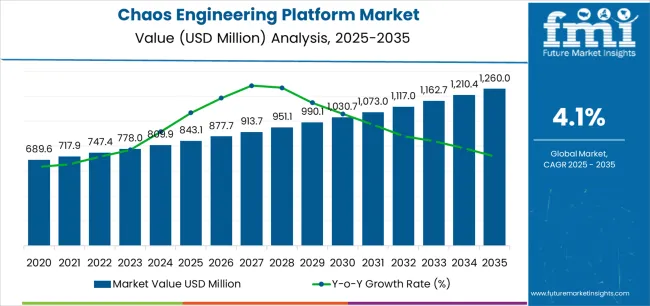
Where revenue comes from - now vs next (industry-level view)?
| Period | Primary Revenue Buckets | Share | Notes |
|---|---|---|---|
| Today | Platform subscriptions (cloud-based, on-premise) | 48% | SaaS-led, enterprise-driven adoption |
| Professional services & implementation | 24% | Custom scenarios, integration support | |
| Training & certification programs | 14% | Team enablement, best practices | |
| Support & maintenance | 14% | Technical assistance, platform updates | |
| Future (3-5 yrs) | Cloud-native platforms | 52-56% | Kubernetes-native, microservices focus |
| AI-powered experiment design | 14-18% | Automated scenario generation, intelligent testing | |
| Managed chaos services | 12-16% | Fully managed experiments, expert guidance | |
| Integration marketplace | 8-12% | Pre-built connectors, ecosystem partnerships | |
| Consulting & optimization | 8-11% | Resilience strategy, architecture review | |
| Data & analytics services | 4-7% | Reliability insights, incident correlation |
| Metric | Value |
|---|---|
| Market Value (2025) | USD 843.1 million |
| Market Forecast (2035) | USD 1,260 million |
| Growth Rate | 4.1% CAGR |
| Leading Deployment Type | Cloud-Based Platforms |
| Primary Application | Financial Segment |
The market demonstrates strong fundamentals with cloud-based platforms capturing a dominant share through advanced scalability capabilities and software reliability optimization. Financial applications drive primary demand, supported by increasing system complexity and regulatory resilience requirements. Geographic expansion remains concentrated in developed markets with established cloud infrastructure, while emerging economies show accelerating adoption rates driven by digital transformation initiatives and rising reliability standards.
Primary Classification: The market segments by deployment type into cloud-based platforms and local deployment solutions, representing the evolution from on-premise testing tools to sophisticated cloud-native resilience systems for comprehensive software reliability optimization.
Secondary Classification: Application segmentation divides the market into financial services, e-commerce, telecommunications, and other specialized sectors, reflecting distinct requirements for system uptime, transaction reliability, and service availability standards.
Regional Classification: Geographic distribution covers North America, Latin America, Western Europe, Eastern Europe, East Asia, South Asia Pacific, and Middle East & Africa, with developed markets leading adoption while emerging economies show accelerating growth patterns driven by digital infrastructure expansion programs.
The segmentation structure reveals technology progression from basic failure injection tools toward sophisticated resilience platforms with enhanced automation and safety capabilities, while application diversity spans from financial institutions to telecommunications operations requiring precise system reliability validation solutions.
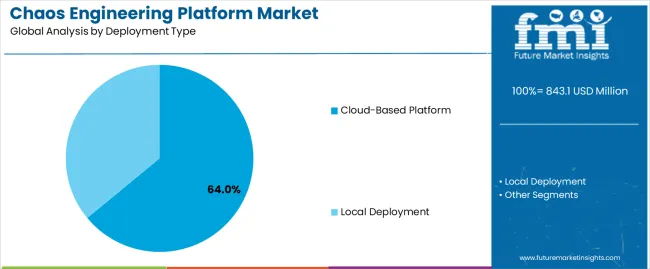
Market Position: Cloud-based platforms command the leading position in the chaos engineering platform market with 64% market share through advanced scalability features, including rapid deployment, elastic infrastructure support, and software reliability optimization that enable technology organizations to achieve consistent resilience testing across diverse cloud and hybrid environments.
Value Drivers: The segment benefits from enterprise preference for flexible platform systems that provide continuous experimentation capabilities, minimal infrastructure overhead, and operational efficiency optimization without requiring significant on-premise investment. Advanced platform features enable automated experiment orchestration, multi-cloud support, and integration with existing DevOps toolchains, where deployment speed and platform accessibility represent critical operational requirements.
Competitive Advantages: Cloud-based platforms differentiate through proven scalability, rapid time-to-value, and compatibility with modern cloud architectures that enhance reliability effectiveness while maintaining optimal safety standards suitable for diverse financial and e-commerce applications.
Key market characteristics:
Local deployment solutions maintain a 36% market position in the chaos engineering platform market due to their security advantages and compliance benefits. These systems appeal to organizations requiring on-premise control with enhanced data sovereignty for regulated applications. Market growth is driven by financial sector expansion, emphasizing secure testing solutions and operational control through dedicated deployment models.
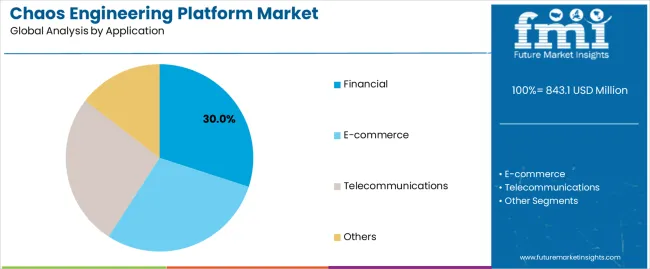
Market Context: Financial applications show the highest market share growth in the chaos engineering platform market, accounting for 30% of the market in 2025. This growth is driven by the widespread adoption of digital banking systems and an increasing focus on transaction reliability optimization, system uptime efficiency, and regulatory compliance applications that maximize service availability while maintaining resilience standards.
Appeal Factors: Financial institutions prioritize system reliability, failure prevention, and integration with existing technology infrastructure that enables coordinated resilience testing across multiple service components. The segment benefits from substantial digital transformation investment and cloud migration programs that emphasize the acquisition of advanced chaos platforms for reliability optimization and incident prevention applications.
Growth Drivers: Digital banking programs incorporate chaos engineering as standard practice for system operations, while fintech expansion increases demand for continuous resilience validation capabilities that comply with regulatory standards and minimize service disruptions.
Market Challenges: Stringent regulatory requirements and production testing restrictions may limit experiment scope across different financial scenarios or operational environments.
Application dynamics include:
E-commerce applications capture 25% share through critical uptime requirements in online retail, marketplace platforms, and digital commerce operations. These organizations demand robust testing systems capable of validating high-traffic scenarios while providing effective failure detection and recovery capabilities.
Telecommunications applications account for 20% share, including network operations, service delivery platforms, and infrastructure management requiring continuous availability capabilities for service optimization and reliability assurance.
| Category | Factor | Impact | Why It Matters |
|---|---|---|---|
| Driver | Cloud-native application growth & microservices adoption | ★★★★★ | Complex distributed systems require proactive resilience testing with controlled failure injection and automated recovery validation. |
| Driver | Digital transformation & customer experience priorities | ★★★★★ | Turns chaos engineering from "optional" to "essential"; providers that deliver safe experimentation and actionable insights gain competitive advantage. |
| Driver | Regulatory compliance & resilience requirements (financial services, healthcare) | ★★★★☆ | Regulated industries need validated reliability; demand for compliant platforms and audit-ready documentation expanding addressable market. |
| Restraint | Cultural resistance & fear of production testing | ★★★★☆ | Organizations fear controlled chaos; increases adoption hesitation and slows platform deployment despite proven safety mechanisms. |
| Restraint | Complexity & specialized expertise requirements | ★★★☆☆ | Teams face steep learning curves and methodology challenges, limiting rapid adoption and increasing implementation complexity. |
| Trend | Automated experiment design & AI-driven testing | ★★★★★ | Machine learning for intelligent scenario generation, automated hypothesis testing, and predictive failure analysis transform operations; AI becomes core differentiation. |
| Trend | Shift-left resilience & development integration | ★★★★☆ | Earlier testing in development lifecycle; IDE integration and pre-production validation drive competition toward developer-friendly solutions. |
The chaos engineering platform market demonstrates varied regional dynamics with Growth Leaders including China (5.5% growth rate) and India (5.1% growth rate) driving expansion through digital transformation initiatives and cloud infrastructure development. Steady Performers encompass United States (3.8% growth rate), Germany (4.7% growth rate), and developed regions, benefiting from established technology sectors and DevOps adoption. Emerging Markets feature Brazil (4.3% growth rate) and developing regions, where digital initiatives and cloud modernization support consistent growth patterns.
Regional synthesis reveals East Asian markets leading adoption through digital transformation and technology infrastructure development, while North American countries maintain steady expansion supported by DevOps advancement and reliability engineering standardization requirements. European markets show moderate growth driven by financial applications and compliance integration trends.
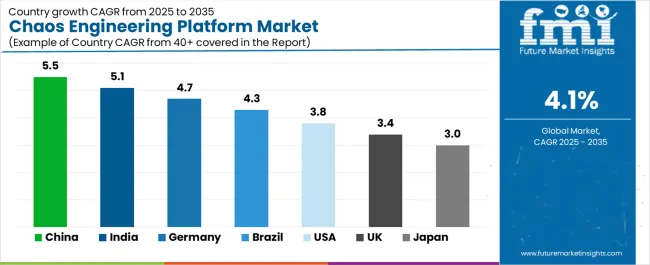
| Region/Country | 2025-2035 Growth | How to win | What to watch out |
|---|---|---|---|
| China | 5.5% | Lead with cloud-native platforms | Data sovereignty requirements; local competition |
| India | 5.1% | Focus on cost-effective solutions | Budget constraints; adoption maturity |
| Germany | 4.7% | Offer compliance-focused platforms | Risk aversion; lengthy approval cycles |
| Brazil | 4.3% | Value-oriented packages | Economic volatility; infrastructure gaps |
| USA | 3.8% | Provide enterprise integrations | Market saturation; vendor consolidation |
| UK | 3.4% | Push financial sector solutions | Conservative adoption; regulatory complexity |
| Japan | 3.0% | Emphasize stability features | Cultural resistance; traditional practices |
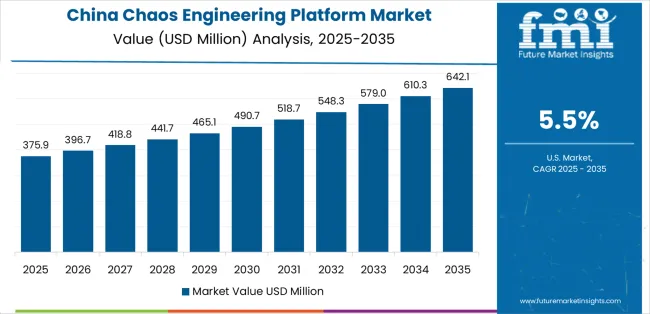
China establishes fastest market growth through aggressive digital transformation programs and comprehensive cloud infrastructure development, integrating advanced chaos engineering platforms as standard tools in technology operations and digital service delivery. The country's 5.5% growth rate reflects government initiatives promoting digital innovation and cloud-native architectures that encourage the use of reliability testing platforms in technology and financial facilities. Growth concentrates in major technology hubs, including Beijing, Shanghai, and Shenzhen, where digital infrastructure showcases integrated chaos engineering that appeals to technology organizations seeking advanced reliability capabilities and system optimization applications.
Chinese technology companies are developing localized chaos platforms that combine domestic cloud advantages with effective testing features, including automated experiment design and safety control capabilities. Distribution channels through cloud service providers and DevOps tool vendors expand market access, while digital transformation initiatives support adoption across diverse technology and financial segments.
Strategic Market Indicators:
In Bangalore, Hyderabad, and Mumbai, technology companies and digital service providers are implementing chaos engineering platforms as standard tools for reliability testing and system optimization applications, driven by increasing digital transformation investment and technology capability programs that emphasize the importance of resilience engineering. The market holds a 5.1% growth rate, supported by startup ecosystem growth and cloud adoption programs that promote chaos platforms for technology and financial facilities. Indian organizations are adopting testing platforms that provide effective reliability validation and cost-efficient features, particularly appealing in technology regions where system uptime and customer experience represent critical operational requirements.
Market expansion benefits from growing cloud-native development capabilities and international technology partnerships that enable domestic adoption of chaos engineering for application and infrastructure testing. Technology adoption follows patterns established in DevOps tools, where operational efficiency and reliability drive procurement decisions and platform deployment.
Market Intelligence Brief:
United States establishes market leadership through comprehensive DevOps practices and advanced cloud infrastructure adoption, integrating chaos engineering across technology and financial applications. The country's 3.8% growth rate reflects established reliability engineering culture and mature platform adoption that supports widespread use of chaos testing systems in technology and enterprise facilities. Growth concentrates in major technology centers, including Silicon Valley, Seattle, and New York, where technology innovation showcases mature chaos engineering deployment that appeals to organizations seeking proven reliability capabilities and incident prevention applications.
American platform providers leverage established technology ecosystems and comprehensive service capabilities, including implementation programs and expert support that create customer relationships and operational advantages. The market benefits from mature DevOps practices and reliability requirements that encourage chaos platform use while supporting methodology advancement and integration optimization.
Market Intelligence Brief:
Germany's advanced technology sector demonstrates measured chaos engineering platform deployment with documented effectiveness in financial applications and enterprise systems through integration with existing DevOps processes and technology infrastructure. The country leverages engineering discipline in software reliability and quality systems integration to maintain a 4.7% growth rate. Technology centers, including Berlin, Munich, and Frankfurt, showcase enterprise installations where chaos platforms integrate with comprehensive observability systems and incident management to optimize reliability operations and system effectiveness.
German organizations prioritize platform safety and regulatory compliance in chaos engineering adoption, creating demand for enterprise-grade platforms with advanced features, including audit capabilities and automated safety controls. The market benefits from established quality engineering frameworks and a methodical approach to reliability testing that provides structured adoption and compliance with international standards.
Market Intelligence Brief:
Brazil's market expansion benefits from diverse digital transformation demand, including fintech modernization in São Paulo and Rio de Janeiro, e-commerce platform upgrades, and technology initiatives that increasingly incorporate chaos solutions for reliability optimization applications. The country maintains a 4.3% growth rate, driven by rising digital services activity and increasing recognition of resilience testing benefits, including incident prevention and customer experience improvement.
Market dynamics focus on cost-effective chaos platforms that balance reliable testing capabilities with affordability considerations important to Brazilian technology organizations. Growing digital economy development creates continued demand for modern reliability platforms in startup ecosystems and enterprise modernization projects.
Strategic Market Considerations:
United Kingdom's financial technology market shows advanced chaos engineering adoption with established DevOps practices and reliability engineering capabilities. The country maintains a 3.4% growth rate through digital banking initiatives and fintech innovation programs. Technology centers in London, Edinburgh, and Manchester demonstrate chaos platform deployments that support financial services reliability and digital experience requirements.
Market development focuses on regulatory compliance and customer experience optimization that incorporate chaos engineering for service reliability and incident prevention. British organizations prioritize controlled testing and audit readiness in platform selection decisions.
Market Intelligence Brief:
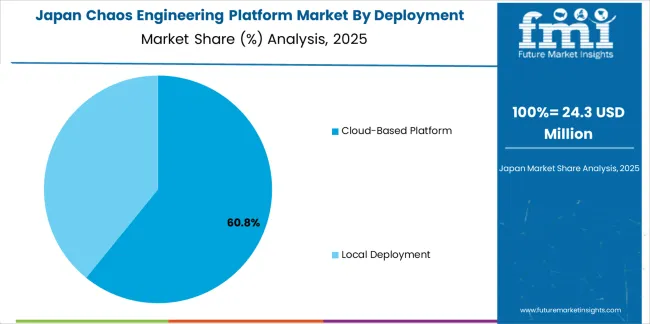
Japan establishes conservative market position through established technology practices and quality-focused development culture, maintaining a 3.0% growth rate driven by gradual reliability engineering adoption and methodology evolution. The country's mature technology sector shows measured chaos platform deployment across enterprise systems and digital services.
Market dynamics center on stability preservation and controlled testing approaches rather than aggressive experimentation, with organizations seeking proven platforms and extensive safety controls through established chaos engineering implementations.
Strategic Market Considerations:
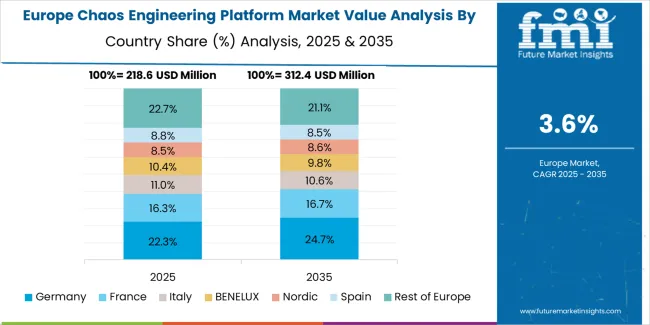
The chaos engineering platform market in Europe is projected to grow from USD 309.2 million in 2025 to USD 426.6 million by 2035, registering a CAGR of 3.3% over the forecast period. Germany is expected to maintain its leadership position with a 32.8% market share in 2025, supported by its advanced technology infrastructure and major financial centers.
United Kingdom follows with a 26.4% share in 2025, driven by comprehensive fintech programs and digital banking initiatives. France holds a 18.2% share through specialized technology applications and e-commerce platform requirements. Italy commands a 11.9% share, while Spain accounts for 10.7% in 2025. The rest of Europe region is anticipated to gain momentum, expanding its collective share from 5.8% to 6.4% by 2035, attributed to increasing DevOps adoption in Nordic countries and emerging technology hubs implementing reliability engineering programs.
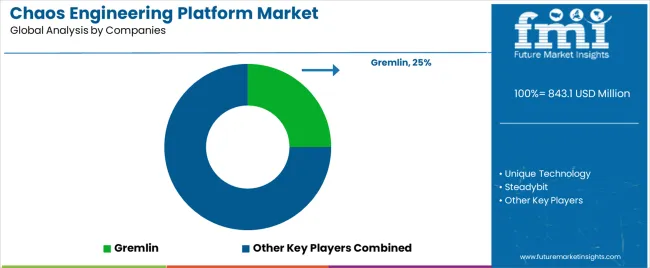
The chaos engineering platform market exhibits a moderately consolidated structure with 12-16 credible players, where the top 4-5 providers control approximately 58-64% of revenue. Market leadership is maintained through platform capabilities, safety mechanisms, and comprehensive integration ecosystems in reliability engineering. Competition centers on experiment automation, safety controls, and seamless DevOps integration that ensures effective resilience validation across diverse cloud environments.
Technology innovation focuses on AI-powered experiment design, automated hypothesis generation, and predictive failure analysis that provides actionable reliability insights. Providers with established cloud platform partnerships and comprehensive safety frameworks create competitive advantages, while managed service offerings and expert consultation differentiate full-solution providers from platform-only vendors.
Commoditization affects basic failure injection tools and open-source alternatives, while margin opportunities exist in enterprise platforms, managed chaos services, and comprehensive resilience consulting. Market participants differentiate through platform intelligence, safety innovation, and proven track records with production chaos engineering.
| Stakeholder | What they actually control | Typical strengths | Typical blind spots |
|---|---|---|---|
| Global platforms | Technology portfolios, cloud partnerships, enterprise relationships | Proven safety, multi-cloud support, comprehensive features | Open-source competition; emerging market pricing |
| Technology innovators | Advanced automation; AI capabilities; novel approaches | Feature leadership; intelligent testing; developer experience | Enterprise sales; service infrastructure |
| Regional specialists | Local presence, compliance expertise, implementation services | Proximity advantages; regulatory knowledge; responsive support | Platform breadth; global scalability |
| Open-source ecosystems | Community platforms, methodology education, basic tools | Adoption barriers removed; methodology spread; vendor independence | Monetization challenges; enterprise features |
| Item | Value |
|---|---|
| Quantitative Units (2025) | USD 843.1 million |
| Deployment Type | Cloud-based, Local Deployment |
| Application | Financial, E-commerce, Telecommunications, Others |
| Regions Covered | North America, Latin America, Western Europe, Eastern Europe, East Asia, South Asia Pacific, Middle East & Africa |
| Countries Covered | United States, China, Germany, India, United Kingdom, Japan, Brazil, and 18+ additional countries |
| Key Companies Profiled | Unique Technology, Gremlin, Steadybit, Amazon Web Services, Harness, Cavisson Systems, Quinnox, WireMock, Chaos Toolkit, LitmusChaos |
| Additional Attributes | Dollar sales by deployment type and application categories, regional adoption trends across East Asia, North America, and Western Europe, competitive landscape with chaos platform providers and DevOps tool vendors, technology organization preferences for safety controls and integration capabilities, compatibility with cloud platforms and observability systems, innovations in experiment automation and AI-powered testing, and development of managed services with enhanced reliability and operational optimization capabilities. |
The global chaos engineering platform market is estimated to be valued at USD 843.1 million in 2025.
The market size for the chaos engineering platform market is projected to reach USD 1,260.0 million by 2035.
The chaos engineering platform market is expected to grow at a 4.1% CAGR between 2025 and 2035.
The key product types in chaos engineering platform market are cloud-based platform and local deployment.
In terms of application, financial segment to command 30.0% share in the chaos engineering platform market in 2025.






Full Research Suite comprises of:
Market outlook & trends analysis
Interviews & case studies
Strategic recommendations
Vendor profiles & capabilities analysis
5-year forecasts
8 regions and 60+ country-level data splits
Market segment data splits
12 months of continuous data updates
DELIVERED AS:
PDF EXCEL ONLINE
Engineering Service Outsourcing Industry Analysis in North America Size and Share Forecast Outlook 2025 to 2035
Engineering Service Outsourcing Market Analysis - Size, Share, & Forecast Outlook 2025 to 2035
Engineering Analytics Market Growth & Demand 2025 to 2035
Engineering Plastic Market Analysis - Size, Share & Forecast 2025 to 2035
Geoengineering Market Analysis – Size, Demand & Forecast 2025 to 2035
Civil Engineering Market Size and Share Forecast Outlook 2025 to 2035
Nuclear Engineering Service Market Size and Share Forecast Outlook 2025 to 2035
Network Engineering Service Market Trends – Demand & Forecast 2025 to 2035
Aerospace Engineering Services Outsourcing (ESO) Market Analysis - Size, Share, and Forecast Outlook (025 to 2035
3D Reverse Engineering Software Market Forecast and Outlook 2025 to 2035
Automotive Engineering Service Outsourcing Market Size and Share Forecast Outlook 2025 to 2035
Automotive Engineering Services Market Growth - Trends & Forecast 2025 to 2035
Computer-aided Engineering Market Analysis - Size, Share, and Forecast 2025 to 2035
Protein/Antibody Engineering Market Size and Share Forecast Outlook 2025 to 2035
Civil Construction Design And Detailing Engineering Market Size and Share Forecast Outlook 2025 to 2035
Platform Lifts Market Size and Share Forecast Outlook 2025 to 2035
Platform Architecture Market Size and Share Forecast Outlook 2025 to 2035
Platform Boots Market Trends - Growth & Industry Outlook to 2025 to 2035
Platform Shoes Market Trends - Demand & Forecast 2025 to 2035
Platform Trolley Market Growth – Trends & Forecast 2025 to 2035

Thank you!
You will receive an email from our Business Development Manager. Please be sure to check your SPAM/JUNK folder too.
Chat With
MaRIA